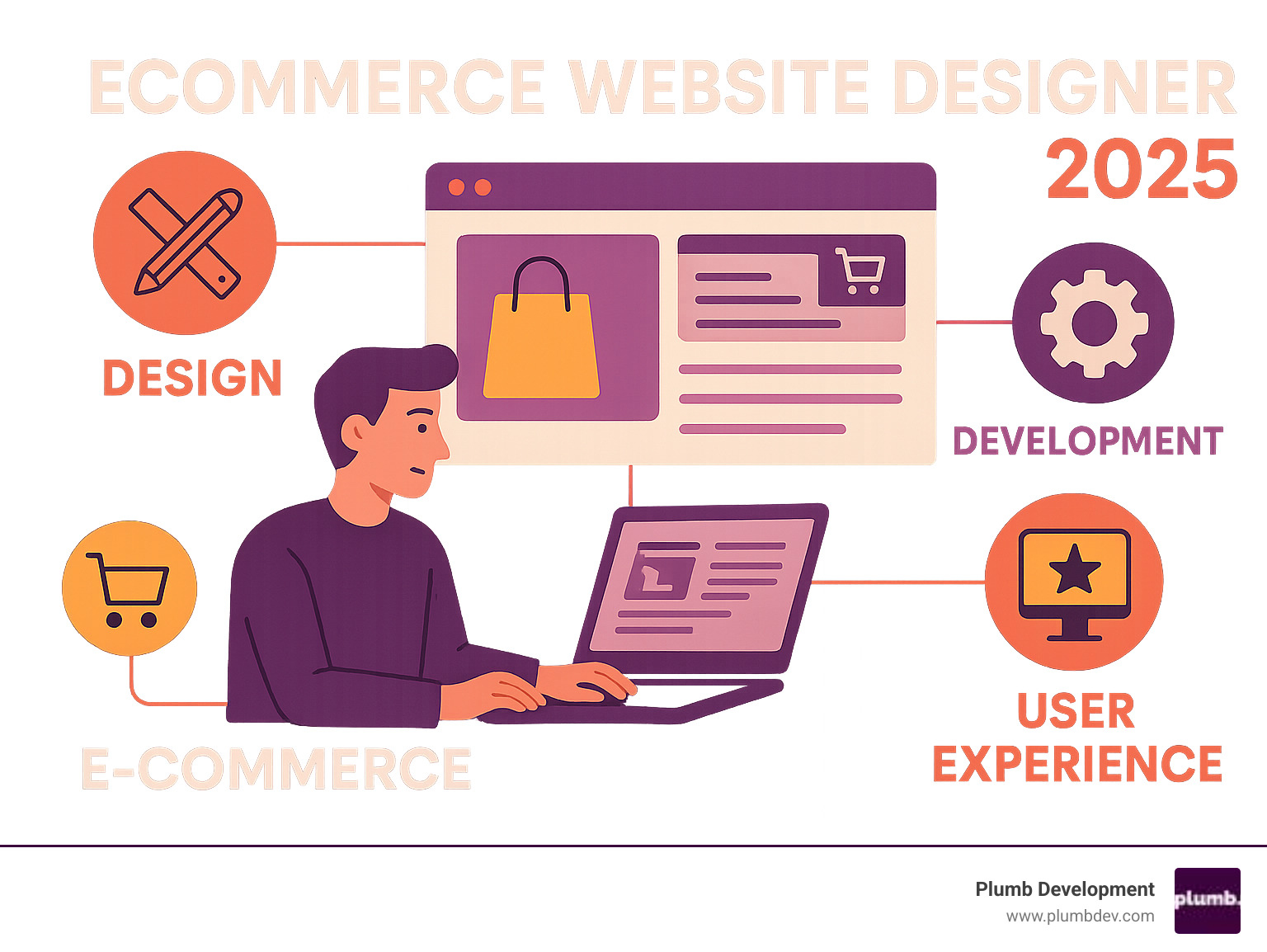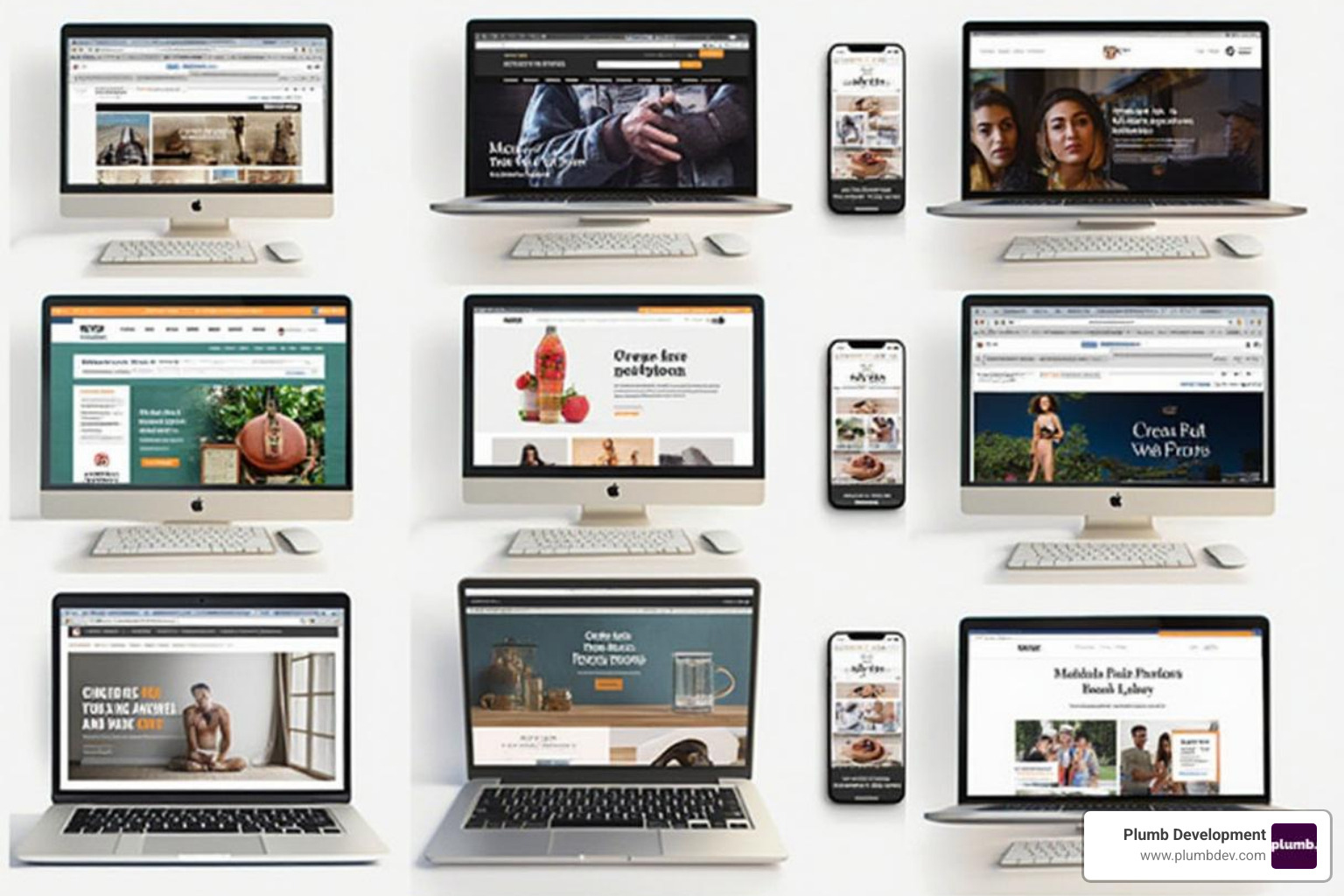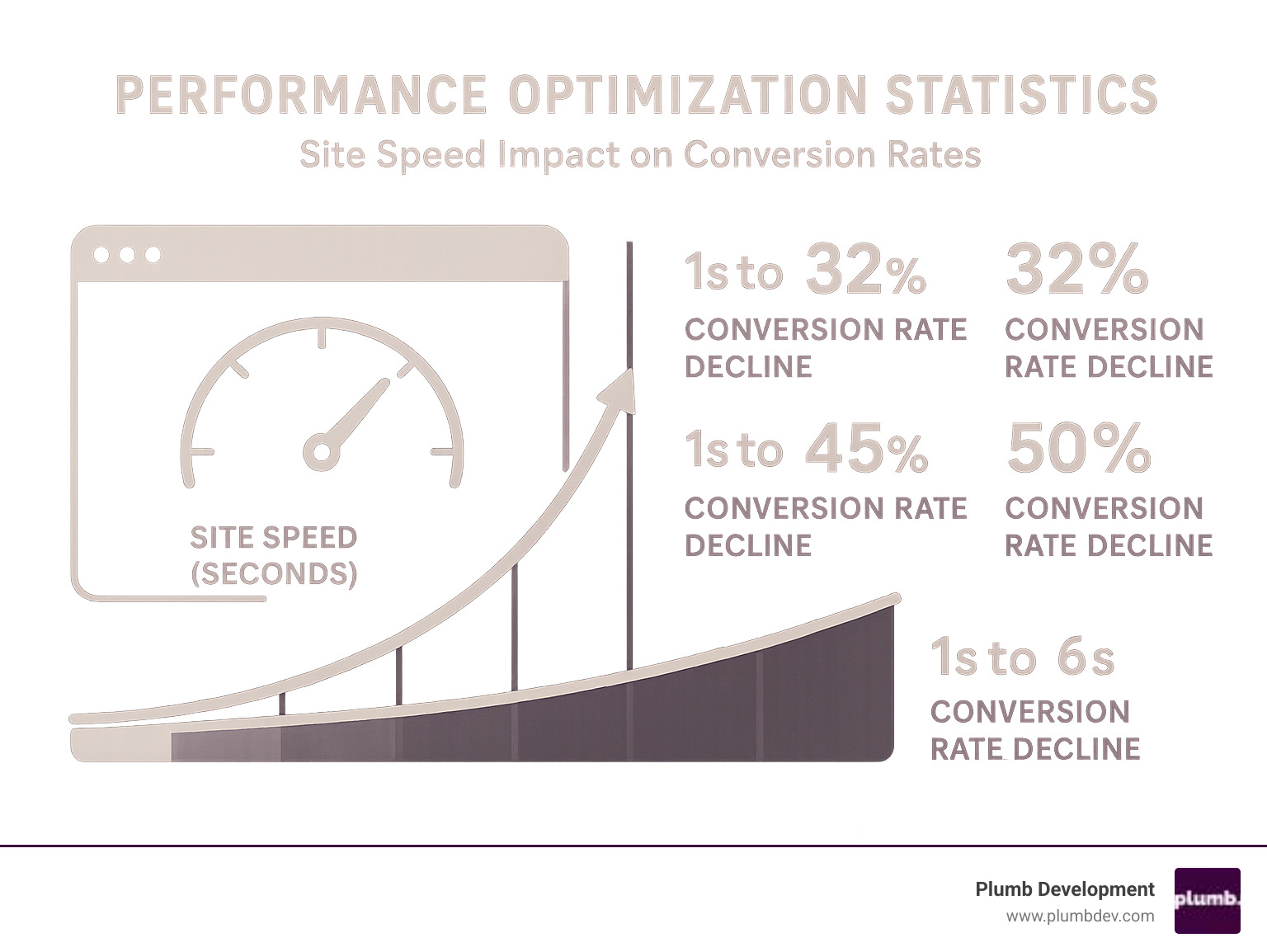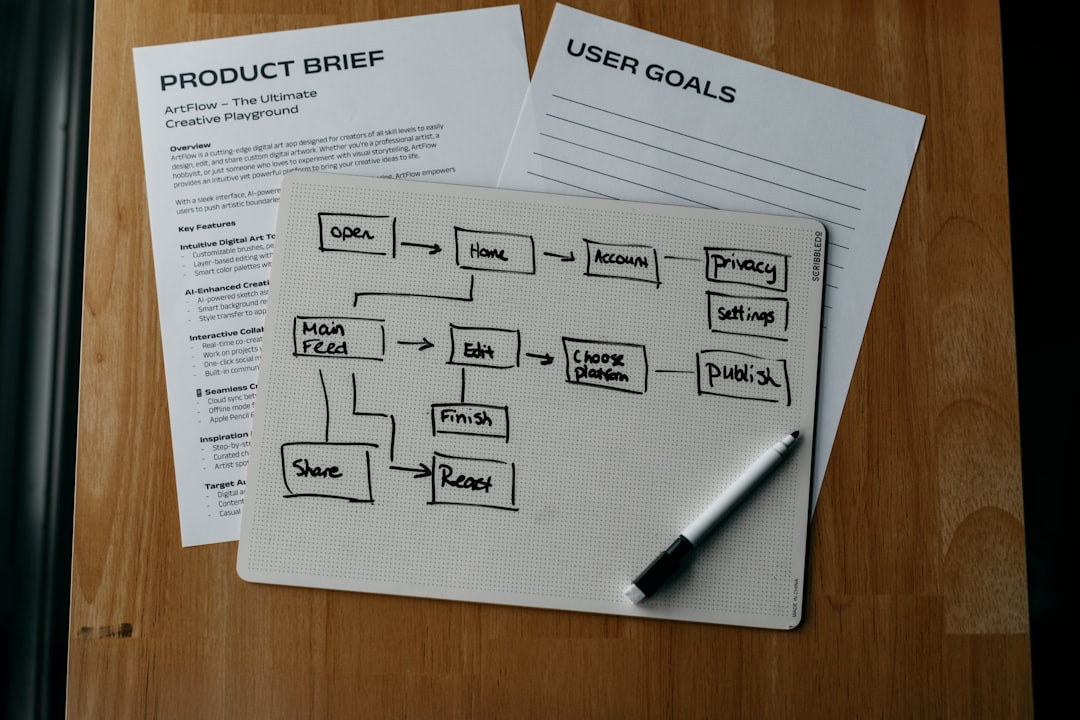Why First Impressions Matter More Than Ever in Ecommerce
An ecommerce website designer creates the digital storefront that turns browsers into buyers, combining visual appeal with conversion-focused functionality to maximize online sales.
What an ecommerce website designer does:
- Designs custom storefronts that reflect your brand and drive conversions
- Optimizes user experience across all devices and screen sizes
- Implements conversion strategies like streamlined checkout flows and trust signals
- Ensures technical performance including site speed, security, and mobile responsiveness
- Integrates essential features such as payment gateways, inventory management, and analytics
Your website has exactly 50 milliseconds to make a first impression - that's faster than the blink of an eye. Research shows visitors decide whether to stay or leave your site in this split second, making visual design the most critical factor in ecommerce success.
Think about it: when someone lands on your online store, they're not just evaluating your products. They're subconsciously judging your credibility, professionalism, and trustworthiness based purely on how your site looks and feels.
The difference between a DIY template and professional design isn't just aesthetics - it's revenue. While 75% of Canadian consumers shopped online in 2023, generating $2.34 billion, only stores with compelling design and seamless user experience capture their share of this growing market.

15 Jaw-Dropping Online Store Designs to Inspire You
The best way to understand what makes an ecommerce website designer truly exceptional is to see their work in action. We've handpicked 15 outstanding online stores that prove design isn't just about looking pretty - it's about converting visitors into customers.
Pure Cycles shows us how powerful minimalist fashion layouts can be. Their clean design lets their beautiful bicycles take center stage with no distractions.
Death Wish Coffee throws minimalism out the window with their bold red color scheme that perfectly captures the intensity of "the world's strongest coffee."
KETNIPZ takes storytelling scroll to a new level, changing their quirky Instagram comic origins into an interactive website experience that feels like stepping into their cartoon world.
MVMT watches greets visitors with compelling product video hero sections that show their timepieces in motion - something static images can't capture.

Hardgraft proves that micro-animations can lift a luxury brand. Their subtle movement effects create that premium feel customers expect from high-end leather goods.
Finn takes a different approach with their interactive quiz feature, guiding dog owners through personalized recommendations instead of overwhelming them with choices.
Allbirds demonstrates that accessibility focus doesn't mean boring design. Their sustainable brand aesthetic follows WCAG guidelines while looking stunning.
Verve Coffee Roasters showcases the power of high-res photography. Their images tell the entire story from farm to cup.
Beardbrand masters social proof widgets by weaving customer reviews naturally throughout their site instead of cramming testimonials into one section.
Tessemae's streamlined their purchasing process into a one-page checkout experience, eliminating abandoned carts from complicated processes.
Chubbies makes their loyalty banner impossible to miss, turning repeat customers into brand evangelists through rewards that feel like joining an exclusive club.
Kylie Cosmetics handles their multilingual toggle with impressive elegance, letting international customers switch languages seamlessly.
Tiny Organics excels at explaining complex subscription models through clear visual design that parents can understand without reading fine print.
Almond Surfboards creates magic through storytelling scroll, taking visitors on a journey through their craftsmanship process.
Why These Examples Work
What makes these designs effective goes beyond aesthetics. Each succeeds because it understands online shopping psychology.
Visual hierarchy guides visitors naturally from landing to purchase using size, color, and white space strategically.
Emotion-driven copy doesn't just describe products - it sells dreams and solutions. These brands understand people buy better versions of themselves.
Mobile-first design prioritizes phone shopping experiences, working flawlessly across all devices.
Fast-loading performance keeps visitors engaged with stunning visuals that don't sacrifice speed.
Trust signals appear naturally throughout each design, building confidence through integrated reviews and easy-to-find contact information.
Smart upsell sections feel helpful rather than pushy, with related products appearing at the right moment.
These examples prove exceptional ecommerce website designer work isn't about following trends - it's about understanding people and creating experiences that guide them naturally toward purchase.
What an Ecommerce Website Designer Brings to the Table
Think of a professional ecommerce website designer as your digital architect and sales strategist rolled into one. They're building a revenue-generating machine that works 24/7.
Creative direction is where the magic starts. While template builders give you cookie-cutter solutions, professional designers create visual experiences that are uniquely yours, understanding how colors, fonts, and layouts impact purchasing decisions.
Platform expertise means your designer knows systems like Shopify, WooCommerce, and Magento inside and out. They recommend the perfect platform for your specific needs and growth plans.
Custom themes built specifically for your business mean your site won't look like everyone else's, and you won't hit frustrating roadblocks when adding new features.
Conversion strategy is where designers earn their keep. Every element guides visitors toward "add to cart," builds trust through smart review placement, and reduces anxiety with clear policies.
Branding becomes consistent across every touchpoint, reinforcing who you are and why customers should choose you.
SEO architecture gets built into the foundation with proper heading structures and clean code that helps search engines find your products.
Analytics setup shows you what's working through tracking systems that reveal which pages convert best and where visitors get stuck.
Security standards protect both you and customers through PCI compliance, SSL certificates, and technical requirements that keep data safe.
Scalability planning ensures your site grows with your business, handling new product lines and traffic spikes.
DIY BuilderProfessional DesignerTemplate limitationsCustom, unlimited designBasic functionalityAdvanced features & integrationsGeneric appearanceUnique brand expressionLimited supportOngoing partnershipCookie-cutter approachStrategic, data-driven decisions
Role of an ecommerce website designer in conversion optimization
Checkout flow optimization removes friction from the buying process. Designers eliminate unnecessary form fields and steps that cause cart abandonment.
Cart abandonment recovery happens through strategic design elements like exit-intent popups, progress bars, and trust badges that rescue potentially lost sales.
A/B testing lets designers make data-driven decisions, testing different button colors, headlines, or layouts to see what drives more sales.
Heatmap analysis reveals how people actually use your site, showing where visitors click, scroll, and what they ignore.
Skills every ecommerce website designer must master
HTML, CSS, and JavaScript form the technical foundation, affecting both appearance and loading speed.
Platform specialization in Shopify, WooCommerce, and Magento means knowing each system's strengths and limitations.
Design tool mastery in Figma and Sketch creates detailed mockups before building anything.
Conversion rate optimization knowledge means understanding purchasing psychology and building trust.
Strategic copywriting skills create compelling headlines that work with visual elements to drive sales.
Conversion-Boosting Features & Design Best Practices

When you're working with an ecommerce website designer, certain features and design choices can make or break your conversion rates. Think of these as the secret ingredients that turn casual browsers into happy customers.
Responsive design isn't just a nice-to-have anymore - it's absolutely essential. Your customers are shopping on their phones while waiting for coffee, browsing on tablets during lunch breaks, and comparing prices on their laptops at home. A skilled ecommerce website designer ensures your site looks perfect and functions smoothly on every single device.
The magic happens when customers can add items to their cart with one click. No complicated forms, no confusing steps - just simple, friction-free shopping. It's like the difference between a smooth checkout line and one where everyone's fumbling for exact change.
Advanced product filtering becomes your customers' best friend when you have hundreds or thousands of products. Smart filters help shoppers narrow down choices quickly, finding exactly what they want without getting overwhelmed. It's like having a helpful store assistant who knows exactly where everything is.
AI-powered recommendations work behind the scenes like a thoughtful friend who knows your taste. These intelligent suggestions can boost your average order value significantly by showing customers items they didn't even know they wanted.
Never underestimate the power of high-quality product photography. Blurry, poorly lit photos kill sales faster than anything else. Professional images with multiple angles, zoom features, and lifestyle shots help customers feel confident about their purchases. When someone can't touch your product, your photos have to do all the talking.
Video reviews and product demonstrations add that human touch that builds trust. There's something powerful about seeing real customers share their experiences or watching a product in action. It's social proof that actually feels social.
Live chat integration can save the day when customers have questions or concerns. Sometimes a quick answer from a real person is all it takes to turn a hesitant browser into a buyer. It's like having helpful staff available 24/7.
Sticky call-to-action buttons stay visible as customers scroll, making it easy to purchase without hunting for the buy button. They're persistent without being pushy - always there when customers are ready to take action.
Breadcrumb navigation might sound technical, but it's simply showing customers where they are on your site and how they got there. It's like leaving a trail of digital breadcrumbs so people never feel lost in your store.
The technical stuff matters too, even if customers don't see it directly. Semantic markup and structured data help search engines understand your site better, potentially showing rich snippets in search results that make your products stand out.
Speed optimization through CDN and performance tuning ensures your site loads lightning-fast. Every second of delay can cost you sales - customers simply won't wait for slow sites when competitors are just a click away.
PCI compliance and visible security measures build the trust that's essential for online purchases. Security badges and SSL certificates might seem small, but they provide the peace of mind customers need to enter their payment information.
The importance of getting these details right can't be overstated. Scientific research on first-impression speed shows that visitors form lasting opinions about your site in just 50 milliseconds. That's why professional design and these conversion-focused features are so crucial.
For New Hampshire businesses looking to implement these best practices, comprehensive solutions are available through Online Business Ecommerce Payments Cloud Services NH, ensuring all these elements work together seamlessly to drive sales and growth.
From Consultation to Launch: Working With a Designer

Working with an ecommerce website designer should feel like gaining a trusted partner. The best designers walk you through each step, ensuring you understand what's happening and why it matters.
The journey starts with a findy workshop – a conversation about your dreams and goals. Your designer asks important questions: Who are your customers? What keeps them up at night? What makes them choose you? These details become the foundation of everything that follows.
Competitor analysis comes next, where your designer studies your industry to find opportunities others have missed, spotting trends and identifying ways to make your store stand out.
Blueprint creation through sitemaps and wireframes shows where everything goes and how people move through your space. This foundation ensures customers find what they need without getting lost.
Prototype iterations bring your site to life before development begins. You'll test interactive mockups, making changes easily at this stage rather than after everything's built.
Content population is where your brand voice shines through product descriptions, category pages, and checkout copy that converts visitors into customers.
Staging and quality assurance tests everything multiple times across different devices, ensuring perfect functionality and fast loading speeds.
Launch day runs smoothly with detailed checklists handling DNS settings, security certificates, and analytics tracking.
Post-launch support means having someone in your corner for questions and new features. The relationship continues beyond launch.
For businesses ready to take their online presence seriously, Best NH Ecommerce Website Design Services Firm provides the complete journey from first conversation to long-term success.
Budget factors every ecommerce website designer will discuss
Feature complexity makes the biggest difference. Standard shopping functionality requires less investment than custom configurators or subscription management.
Product catalog size affects architecture and search functionality. A boutique with 50 items needs different solutions than a retailer managing thousands of SKUs.
Third-party integrations connect your website to business tools like inventory management, email marketing, and accounting software.
Custom applications like size calculators or quote systems require specialized development but become competitive advantages.
How an ecommerce website designer ensures security, scalability, and performance
SSL certificate setup encrypts information between customers and your website, protecting data and building trust.
Server-side caching makes websites lightning fast by storing frequently accessed information in memory.
Code optimization means clean programming that loads quickly through compressed images and minimized files.
Auto-scaling hosting automatically adjusts resources based on traffic, keeping sites responsive during spikes.
Frequently Asked Questions about Ecommerce Website Designers
When you're ready to hire an ecommerce website designer, you probably have questions about this important business decision.
What platforms do professional designers recommend for different business sizes?
Shopify works beautifully for most small to medium businesses who want simplicity without sacrificing power. It handles hosting, security updates, and maintenance while allowing customization.
WooCommerce appeals to businesses that love WordPress or want complete control. It offers unlimited customization but requires more technical maintenance.
Magento serves enterprise-level businesses with complex needs like multiple stores, advanced B2B features, or intricate product catalogs.
Your ecommerce website designer will evaluate your needs and recommend the platform that best fits your goals and capabilities.
How much does it cost to hire an ecommerce website designer?
Investment varies based on complexity and requirements.
Simple template customizations work for straightforward stores with basic needs, focusing on modifying existing themes to match your brand.
Custom design projects represent the sweet spot for most growing businesses, creating unique designs custom to your brand and customers.
Enterprise-level projects involve complex functionality and extensive customization for large businesses with specific requirements.
Professional design typically pays for itself through improved conversion rates, often converting 2-3 times better than DIY templates.
What questions should I ask before signing a contract?
Ask to see their portfolio with examples relevant to your industry. Look for results those sites achieved - did conversions improve? How much did traffic increase?
Understand their process completely. How do they handle feedback? What happens if you need changes? When do you see first designs?
Discuss timeline expectations realistically. Good design takes time for content creation, feedback cycles, and testing.
Clarify ownership rights. Who owns design files after completion? What about the code? Can you take your site elsewhere if needed?
Pin down support terms. What's included after launch? How quickly do they respond to issues? What ongoing maintenance options exist?
Define success metrics together. How will you measure project success? Increased conversions? Better engagement? Lower bounce rates?
The best ecommerce website designers welcome these questions because they want you to feel confident and informed.
Conclusion
The future of ecommerce is happening now. Headless commerce is reshaping how brands connect with customers across multiple touchpoints, maintaining design consistency across websites, mobile apps, and social media.
Augmented reality is becoming a game-changer, letting customers try on sunglasses or place furniture in their living room before buying. Voice shopping through smart speakers is revolutionizing ecommerce design thinking.
Sustainability-focused design reflects deeper consumer consciousness about environmental impact, extending to green hosting and mindful shopping experiences.
Data-driven user experiences keep getting smarter through AI and machine learning, creating shopping experiences that anticipate customer needs.

At Plumb Development, we know exceptional ecommerce design isn't just about aesthetics. It's about understanding purchase psychology, the technology that makes everything work smoothly, and the strategy that turns browsers into loyal customers.
We've seen how the right ecommerce website designer can transform businesses. Well-designed sites become your most effective salesperson, working 24/7 to build trust and guide people toward purchase.
Professional design consistently delivers better conversion rates, happier users, and stronger brand perception. It's an investment that keeps paying dividends.
For businesses throughout New Hampshire and beyond, Best Website Design Development Services NH brings together creative vision and technical expertise to create ecommerce experiences that truly perform.
In ecommerce, you don't get a second chance at first impressions. In those crucial 50 milliseconds, your design either wins or loses. Make it count with professional design that captures attention, builds trust, and turns visitors into customers who return again and again.

